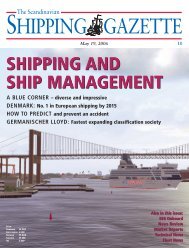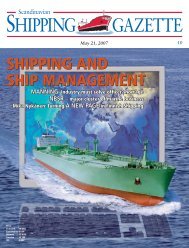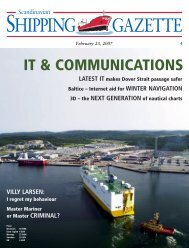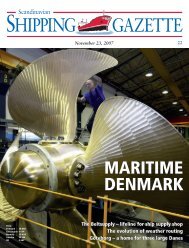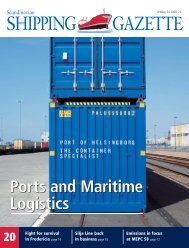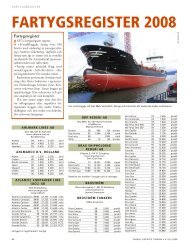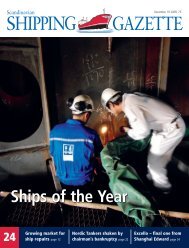SSG No 20 - Shipgaz
SSG No 20 - Shipgaz
SSG No 20 - Shipgaz
You also want an ePaper? Increase the reach of your titles
YUMPU automatically turns print PDFs into web optimized ePapers that Google loves.
PORTs & MARiTiME lOGisTiCs<br />
Three liners, the Kalana, the Dirhami and the Atair J, at the quay of Muuga CT.<br />
Estonian ports<br />
show flexibility<br />
The pressure coming from outside<br />
Estonia has forced the ports to be<br />
flexible. The loss of the flow of some<br />
article may force a single terminal to its<br />
knees, but a certain loss of cargo turnover<br />
has forced terminals and ports alike to<br />
reorganise their operations.<br />
ESTONIA<br />
The downward trend of the cargo turnover<br />
of Estonian ports coincides with the<br />
massive propaganda attack of Russia against<br />
Estonia. The transit of Russian energy carriers<br />
has been affected the most. Transit of<br />
oil products has decreased noticeably, transit<br />
of coal is virtually nonexistent and car<br />
riage of fertilisers and metals has decreased.<br />
However, handling trucks and containers<br />
continues to increase.<br />
Carriage difficulties and presumably also<br />
political pressure has forced Russian businessmen,<br />
who have invested in Estonia, to<br />
adjust their investment plans.<br />
Some terminals have been sold and<br />
some have had to suspend their operations,<br />
the ports reduce the pace of construction<br />
of new structures and are looking for new<br />
trade flows.<br />
The advantage of Estonian ports has<br />
been a good railway connection with ports<br />
that have a suitable depth for large vessels.<br />
The changed situation has forced Russian<br />
businessmen to find other export routes<br />
– cargo arriving from Russia by sea is a new<br />
phenomenon.<br />
Political railway<br />
Last winter, the Estonian state bought<br />
Estonian Railways back from private owners,<br />
but after privatisation two new railway<br />
operators had emerged. <strong>No</strong>w Estonian<br />
Railways receives half of the trains from<br />
the Russian border, compared to the prior<br />
situation, and half of the trains are those of<br />
other operators. The decline in the cargo<br />
turnover has been somewhat compensated<br />
by carriage of Estonian origin, which has<br />
shifted from roads to railways. These can,<br />
in turn, be attributed to long queues of<br />
trucks on the EstonianRussian border.<br />
44 sCAnDinAviAn sHiPPinG GAZETTE • OCTOBER 26, <strong>20</strong>07<br />
MADli viTisMAnn




